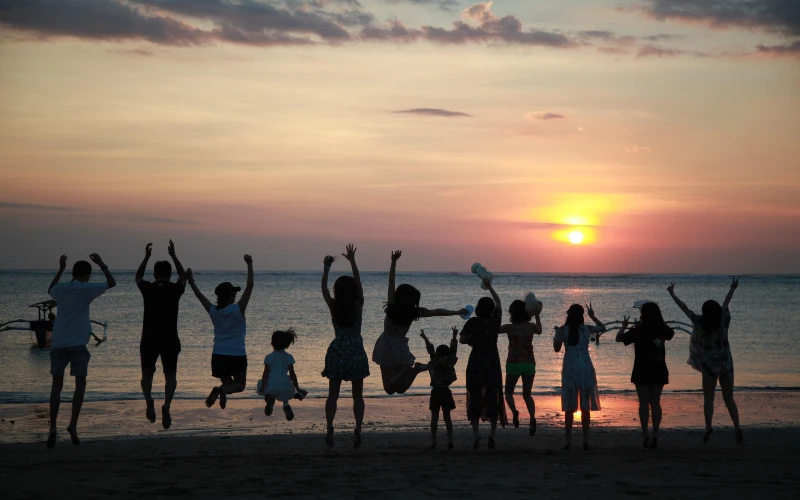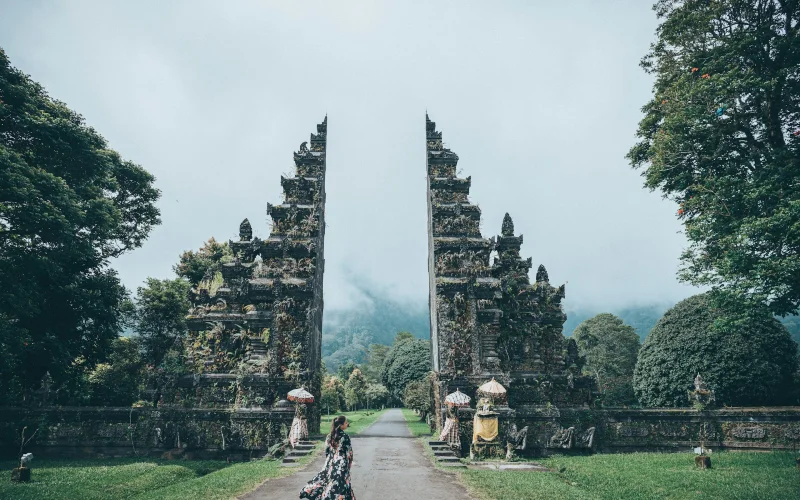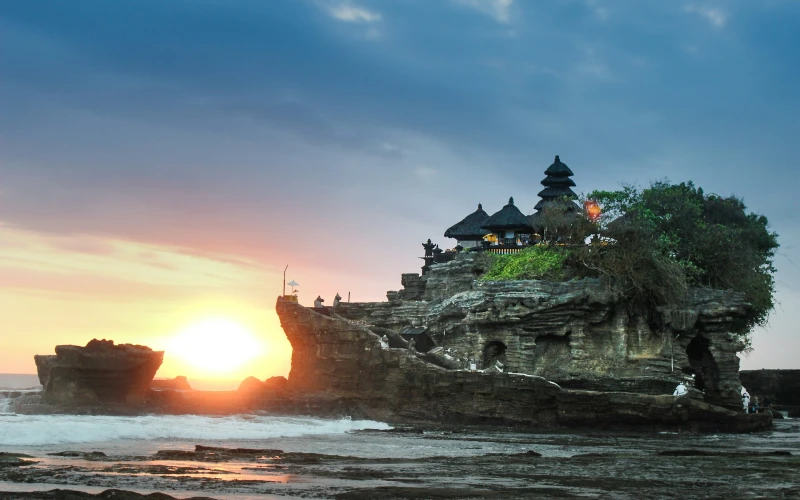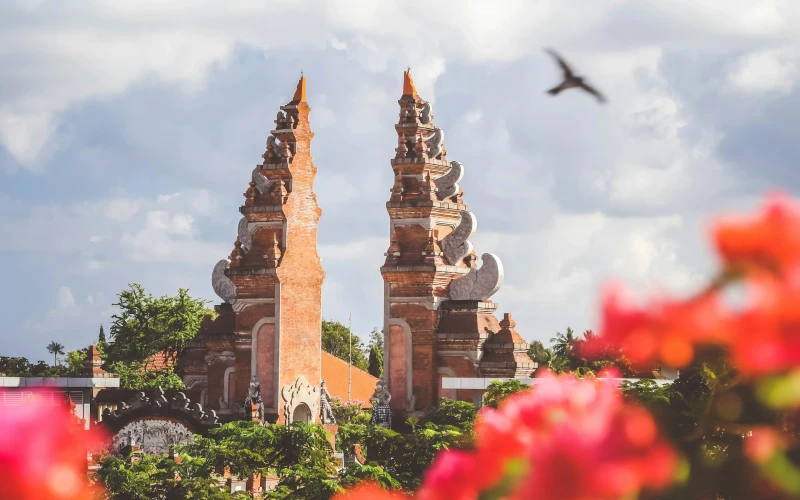A vibrant, tropical, postcard-perfect destination that instantly calms you, Bali is an antidote for a weary soul. This Asian destination, sheathed in lush green terraced paddies, azure waves crashing on white sandy beaches, and ancient temples tucked in verdant wilderness, is one of the most beautiful destinations to visit to unwind and take a break from daily life. It balances out the peaceful ambiance with just the right kick of bustle with its vibrant, colorful markets, quaint towns, and a food scene that will make your taste buds dance. It’s a place you won’t want to leave, a place you won’t want to return home from. The chilled-out vibes and the laid-back life will make you fall in love with Bali. If Bali is on your travel bucket list, you should know when the best time to visit Bali is. Read on to know more.
What’s Bali Like?
 You will fall in love with Bali the moment you arrive. This gorgeous island is one of Indonesia’s 17,000 islands. It lies just east of Java and west of Lombok. With its volcanic mountains, lush forests, colossal waterfalls, coral reef-covered oceans, and sandy beaches, Mother Nature has showed off her best work here! Bali boasts a traditional aspect that draws people in with its beautiful temples and heavenly atmosphere. With its abundant temples, it’s no surprise that Bali earned the nickname ‘Island of a Thousand Temples.’ In addition, it also offers modern sea adventures, providing visitors with a perfect dose of excitement.
You will fall in love with Bali the moment you arrive. This gorgeous island is one of Indonesia’s 17,000 islands. It lies just east of Java and west of Lombok. With its volcanic mountains, lush forests, colossal waterfalls, coral reef-covered oceans, and sandy beaches, Mother Nature has showed off her best work here! Bali boasts a traditional aspect that draws people in with its beautiful temples and heavenly atmosphere. With its abundant temples, it’s no surprise that Bali earned the nickname ‘Island of a Thousand Temples.’ In addition, it also offers modern sea adventures, providing visitors with a perfect dose of excitement.
By the looks of it, you may find Bali to be a sleepy destination, but once you get acquainted, you discover that it has a vibrant and lively side. It will bewitch you with stunning sunsets but also have you grooving to electrifying music at a beach club by night. People are friendly, and their hospitality, gracious vibe, and lip-smacking food will spoil you. Life is blissful here. Start your day with surfing sessions chasing waves, meditate in a temple by noon, or enjoy an open-air yoga session overlooking the verdant wilderness. Then, stroll on the beach during golden hour before letting your hair down and dancing under the stars at night. Somewhere in between, you lazily doze off in the comfort of a spa session. Bali’s got this perfect mix of chill and thrill, tradition and modernity. With many attractions and experiences, include a bit of each aspect to enrich your Bali tour packages.
The food scene and coffee culture are next-level. Did you know that Bali is one of the places in Indonesia producing the infamous and most expensive coffee, Kopi Luwak? This Balinese coffee’s unique harvesting technique, which involves processing it by Asian civet cats, adds a bizarre tale to it, but the coffee lives up to the hype. The island has an international airport, Ngurah Rai International Airport in Denpasar, allowing you to fly in from anywhere in the world.
 Featured
Featured  Featured
Featured Best Time to Visit Bali According to the Seasons
The most anticipated question among first-time visitors is, ‘Is Bali an all-year-round destination?’ Yes, it is, but only if you know exactly what to do in which season. The ubiquitous notion about Bali is that it is always a sunny, tropical destination, but it does experience variations in its seasons. Since Bali is located near the equator, it has only two main seasons: the wet and dry seasons.
Wet Season (November -March)
From November to March, Bali flourishes and thrives with refreshing greenery. However, the region gets so much rainfall that it isn’t the best time to explore the outdoors. But it also means fewer crowds, a quiet ambience, and lower prices. Although Bali is ranked among the cheapest places to travel in the world, the wet season additionally causes a dip in prices. The temperatures hover around 22°C to 29°C, and the ambience is balmy due to dense humidity. So, if you aren’t an outdoor enthusiast and want to focus on wellness, cultural immersion, and indoor adventures, the rains shouldn’t be a bother to you. The season is perfect for tucking into warm ‘soto ayam’ or cozy up in cafes with a freshly roasted and brewed Balinese cup of coffee.
Dry Season(April – October)
The dry season in Bali is your go-to for beach days and outdoor thrills. It’s sunny with clear skies, lower humidity, and a cool breeze, making it perfect for outdoor adventures. This is the time to soak in the sun or surf the waves. Visit Seminyak, Kuta, or Nusa Dua for sunbathing, swimming, and snorkeling. The clear waters around Nusa Penida and the Gili Islands are a diving heaven! Not a watersport lover? No problem! Hit the lush hiking trails and enjoy Bali’s beautiful natural splendors. Temperatures remain around 24°C to 32°C, with May being the hottest. Coastal areas are toasty and sun-kissed, while highlands like Ubud have breezy, milder, sunny days. Don’t forget to check out the local warungs for delicious helpings of nasi campur and fresh seafood delights. Bali during the dry season is one of the top summer vacation spots in the world, keeping your bank balance and you pleased at all times!
Best Time to Visit Bali to Avoid Crowds
 Want to enjoy Bali without the tourist hustle? There is no doubt that the dry season months from April to October are the best time to visit Bali. However, if you’re craving the version of Bali where you can enjoy the attractions without the touristy crowd, the shoulder seasons from April to May and September to October are your best options. You get the island’s charm without elbowing through packed beaches or temples.
Want to enjoy Bali without the tourist hustle? There is no doubt that the dry season months from April to October are the best time to visit Bali. However, if you’re craving the version of Bali where you can enjoy the attractions without the touristy crowd, the shoulder seasons from April to May and September to October are your best options. You get the island’s charm without elbowing through packed beaches or temples.
Best Time to Visit Bali on a Budget
Now, if you’re eyeing a budget holiday, the wet season is when prices for travel facilities come crashing down. However, the shoulder season (April, May, September, and October) is that perfectly balanced time of the year where you can enjoy the outdoors without rain being a spoilsport and still stick to a reasonable budget. Popular spots like Ubud’s Monkey Forest or Tanah Lot Temple are less packed, meaning you can soak up the vibes at your own pace. However, if you’re super strict with your holiday funds, then the wet season is your best bet. Bali’s low season runs from November to March, and that’s when you can take advantage of the low rates and treat yourself to a relaxing vacation at a premium Balinese resort with stunning views and great service. Bali becomes a lush, green paradise during the rainy season. The rice fields in Ubud and Sidemen stand out as striking green, while the waterfalls, like Tegenungan, are at their roaring best. Fewer tourists also mean you can enjoy prime attractions like Uluwatu Temple, Pura Lempuyang and Tirta Empul Temple without the crowds.
Best Time to Visit Bali for Festivals
 If you love cultural immersion in a new destination, Bali will leave you quite content. Balinese locals chart their festivals according to their own Balinese calendar. Bali’s festivals are predominantly Hindu traditions, which means there is a kaleidoscope of colors and spiritual energy in the ambience. There is a lot of fervor in the air, but there are also festivals that celebrate silence. Nyepi is a unique festival observed in Bali, where for the entire day is enveloped in silence and meditation. It is observed at the end of March, and the next day is marked as New Year’s Day in Bali, as per their local calendar.
If you love cultural immersion in a new destination, Bali will leave you quite content. Balinese locals chart their festivals according to their own Balinese calendar. Bali’s festivals are predominantly Hindu traditions, which means there is a kaleidoscope of colors and spiritual energy in the ambience. There is a lot of fervor in the air, but there are also festivals that celebrate silence. Nyepi is a unique festival observed in Bali, where for the entire day is enveloped in silence and meditation. It is observed at the end of March, and the next day is marked as New Year’s Day in Bali, as per their local calendar.
In May, Bali gears up for festival buzz with the much-anticipated Bali Food Festival, where you can sample some of the most irresistible dishes Bali has to offer. Following this is the Bali Art Festival in June. July has a lineup of local cultural festivities like the Jatiluwih Festival, Penglipuran Village Festival, and Ulun Danu Beratan Festival. Bali’s festive energy reaches its peak in August with the Bali Kite Festival, Ubud Village Jazz Festival, Indonesia’s Independence Day, and the Tanah Lot Arts and Food Festival. The dry season weather pairs perfectly with the festivals’ lively energy, making June, July, and August a hotspot for culture lovers and outdoor seekers.
Best Time to Visit Bali for :
Families
 If you’re planning a family adventure to Bali, the dry season (April to October) is the best time to go. The weather is sunny and warm, making the valleys and plains ideal for trekking and enjoying nature. The pleasant daytime temperatures and clear blue skies, with evenings cooling down to a comfy 23°C, are ideal for kids to run around and enjoy the outdoors. It is warm enough to visit the best beaches in Bali, and cool enough for outdoor strolling and exploring terraced rice paddy fields. Hit family-friendly beaches like Sanur with its calm, shallow waters, ideal for little swimmers. If you time it right, catch Galungan, a vibrant Balinese festival with street processions and bamboo props, often held in April or September.
If you’re planning a family adventure to Bali, the dry season (April to October) is the best time to go. The weather is sunny and warm, making the valleys and plains ideal for trekking and enjoying nature. The pleasant daytime temperatures and clear blue skies, with evenings cooling down to a comfy 23°C, are ideal for kids to run around and enjoy the outdoors. It is warm enough to visit the best beaches in Bali, and cool enough for outdoor strolling and exploring terraced rice paddy fields. Hit family-friendly beaches like Sanur with its calm, shallow waters, ideal for little swimmers. If you time it right, catch Galungan, a vibrant Balinese festival with street processions and bamboo props, often held in April or September.
Solo Traveler
 Bali is a solo traveler’s haven! You can find an assortment of people from all corners of the world seeking a unique perspective on lifestyle, ranging from digital nomads to nature adventurers or simply those looking for solace in spirituality. That is the essence of Bali – it accepts everyone and absorbs them as part of it. Bali is fantastic for solo travelers, offering a wide variety of facilities catering to their traveling style. Again, the dry season is the perfect time for spontaneous outdoor plans – whether it’s a sunrise hike up Mount Batur or a scooter ride to hidden beaches. But wait, there’s a catch: peak season means higher prices. For budget-friendly travel, consider visiting in the shoulder months of April, May, September, and October. The best spots to stay are definitely Ubud, Canggu, and Uluwatu, which are brimming with cafes, co-working spaces, hostels, and yoga and wellness retreats.
Bali is a solo traveler’s haven! You can find an assortment of people from all corners of the world seeking a unique perspective on lifestyle, ranging from digital nomads to nature adventurers or simply those looking for solace in spirituality. That is the essence of Bali – it accepts everyone and absorbs them as part of it. Bali is fantastic for solo travelers, offering a wide variety of facilities catering to their traveling style. Again, the dry season is the perfect time for spontaneous outdoor plans – whether it’s a sunrise hike up Mount Batur or a scooter ride to hidden beaches. But wait, there’s a catch: peak season means higher prices. For budget-friendly travel, consider visiting in the shoulder months of April, May, September, and October. The best spots to stay are definitely Ubud, Canggu, and Uluwatu, which are brimming with cafes, co-working spaces, hostels, and yoga and wellness retreats.
Friends and Groups
Want a holiday spot for your squad to catch up? Bali’s beautiful beaches, vibrant food scene, thrilling adventures, and laid-back vibes make it the perfect destination for a group trip. The dry season is ideal for maximum outdoor fun, while the wet season offers budget-friendly deals. The shoulder seasons are also a great time to visit, allowing you to enjoy beach days, go temple hopping, and enjoy late-night parties without sweating a lot. The best place to visit in Bali with friends? It is undoubtedly Canggu! This is where you forget your present life for a moment, go back to your old times of non-stop fun, and enjoy life without worries! Just bask in the laid-back charms, relish Balinese brunches, and hit the café scene. Rent a bike and zip through Canggu’s rice fields and quaint townships, catch up on conversations during stellar sunsets in beach clubs, and go surfing on the high swells of Echo Beach, Batu Bolong, and Berawa! In the shoulder season, Canggu is quieter and is the go-to place for your buddies to connect without the high-season crowd.
Honeymooners
 Lush nature, breezy beaches, stellar sunsets, and spas – Bali has all the right ingredients for planning a dreamy Bali honeymoon for you and your sweetheart. Summers are hands-down the best time to visit, and shoulder season can also be a good time. The perfect amalgam of great weather, fewer crowds, and better deals makes it the ideal time for lovebirds to enjoy romantic times in Bali. It’s scooter rides, warm swims, and spa days throughout! In April and May, the crowds are moderate, so you’ll get that intimate vibe without the peak-season hustle. The clear weather ensures your romantic time together proceeds without any hiccups. If luxury at a steal and indoor pampering are on your mind, Bali’s rains during the wet season won’t dampen your vibe. Moreover, the off-peak season brings temptingly low rates at luxury resorts, an opportunity well worth making the most of. Go on and enjoy those Balinese villas with private pools and elegant spa days, along with exclusive honeymoon perks, all at really cheap costs. Plus, the drenched earthy aroma and the refreshing green landscape, along with the rain showers, add that perfect romantic vibe for a cozy time together.
Lush nature, breezy beaches, stellar sunsets, and spas – Bali has all the right ingredients for planning a dreamy Bali honeymoon for you and your sweetheart. Summers are hands-down the best time to visit, and shoulder season can also be a good time. The perfect amalgam of great weather, fewer crowds, and better deals makes it the ideal time for lovebirds to enjoy romantic times in Bali. It’s scooter rides, warm swims, and spa days throughout! In April and May, the crowds are moderate, so you’ll get that intimate vibe without the peak-season hustle. The clear weather ensures your romantic time together proceeds without any hiccups. If luxury at a steal and indoor pampering are on your mind, Bali’s rains during the wet season won’t dampen your vibe. Moreover, the off-peak season brings temptingly low rates at luxury resorts, an opportunity well worth making the most of. Go on and enjoy those Balinese villas with private pools and elegant spa days, along with exclusive honeymoon perks, all at really cheap costs. Plus, the drenched earthy aroma and the refreshing green landscape, along with the rain showers, add that perfect romantic vibe for a cozy time together.
A Month-to-Month Guide to Visiting Bali
 Alhough Bali’s weather is split into wet and dry seasons, each month has a unique feel to it and brings distinct experiences for its visitors. Knowing Bali weather by month can help you plan your holiday more efficiently.
Alhough Bali’s weather is split into wet and dry seasons, each month has a unique feel to it and brings distinct experiences for its visitors. Knowing Bali weather by month can help you plan your holiday more efficiently.
 Featured
Featured  Featured
Featured January
Average Temperature: 26°C to 28°C
January is the wettest month in Bali. Even though it is low season, many tourists who had spent New Year’s Eve love to extend their holiday into January. It’s an amazing feeling to party all night on New Year’s Eve and then extend your holiday to enjoy the calming ambiance, soothing rains, and lush natural scenery, pampering yourself with de-stressing spa wellness programs and indoor yoga. The wet season brings a raw, untouched beauty to the ambience that makes every moment feel alive. If you feel adventurous, go searching for mighty waterfalls, but make sure you have your rain gear and watch out for slippery moss on the trekking trails.
February
Average Temperature: 24°C to 30°C
The wet season continues in February, and the tourist crowds drastically drop. This means you can visit popular attractions like Tanah Lot Temple and Seminyak beaches without the throngs of tourists. This month offers a relaxed experience even in fine-dining venues and popular food hubs. Humidity is high in February, making it feel somewhat balmy, but those gentle sea breezes keep you comfortable. February’s off-season status means you can grab value-for-money deals on flights, hotels, and tours. It is one of the cheapest times to visit Bali, where you can even think of finally making that ocean-view villa dream at a 5-star resort a reality at a fraction of the cost!
March
Average Temperature: 27°C to 31°C
The weather takes a turn as it’s the tail end of the wet season in Bali. Hence, you’ll witness bursts of tropical rain, usually in the afternoons or evenings during your Bali trip. This is the last month to enjoy the scarce crowds, misty, cool drizzles, and low-cost travel amenities. As the rains bid farewell for the year, you get more sunny time with sporadic showers, which are amazingly refreshing. This is perfect for heading outdoors and venturing to verdant spots like the Jatiluwih or Tegallalang rice terraces. The climate remains warm and humid, with sea temperatures ideal for swimming. The beaches in Nusa Dua, Kuta, and Seminyak are perfect for sunbathing and surfing. The locals celebrate Nyepi in March, a unique festival that celebrates silence through spirituality.
April
Average Temperature: 24°C to 30°C
The rain stops, marking it the beginning of summer in Bali. The temperature rises, and you can see a slight change in the influx of tourists wanting to enjoy the milder, sunny tropical days of the destination. The island transforms from the lush, rain-kissed vibes of March into a sun-soaked paradise, with a hint of vibrant greenery still peppered throughout the landscape. With such a diverse range of climates, April is perfect for beach days, temple visits, and outdoor adventures. The sunsets are fabulous, and the nightlife is lively with sundowner cocktails and DJ nights at beach clubs.
May
Average Temperature: 26°C to 32°C
May is the hottest month in Bali, with temperatures reaching a peak of 32°C. Still, you can lather on sunscreen, put on your sunglasses, and explore the coastal shores. Why not add a hint of water adventure as well? Head to Amed and Kuta for fabulous snorkeling and diving experiences among vibrant coral reefs and marine creatures. The climate turns cooler as evening falls and continues to dip further in the night. Compared to April, it’s drier, livelier, and ideal for water adventures. The surf season on the west coast kicks off, and sunsets are magical, making them perfect Instagrammable spots.
June
Average Temperature: 22°C to 28°C
Bali in June feels warm and sunny. This is the perfect time to book a private scooter and zip around Bali’s winding roads, visiting temples and pausing on your journey at food stalls that have something lip-smacking to satiate your tastebuds. The Ubud Food Festival, which starts at the end of May, extends into this month. Align your travel dates with this event to enjoy the best of Balinese food.
July
Average Temperature: 22°C to 29°C
The sunny days continue; however, there’s a drop in humidity levels, and you can feel that the weather is hot and less sticky this time of the year. The days are best to bask on the sun-soaked beaches. The nights are cool, ideal for sipping cocktails during sundowners. Come July, and you will start spotting giant, vibrant kites dotting the clear blue skies. The destination comes alive with the Gianyar Kite Festival, where you can watch skies filled with giant kites flitting and flying in the wind. The annual International Bali Kite Festival also takes place during July or August in Padanggalak Beach in Sanur. For surfers, July’s seawater sees a lot of steady swells, making it an excellent time to go surfing in Bali.
August
Average Temperature: 22°C to 26°C
The tropical summer continues! Revel in pure tropical bliss, get sun-kissed, and get a tan to flaunt, as the beaches are your haven for an idyllic getaway in August. Spend your days outdoors exploring Bali’s many wonders, as there’s hardly any rainfall to disturb your outdoor tours. The usually vibrant green rice paddy terraces turn golden as harvest season approaches, giving a unique glow to the Balinese landscapes. Seminyak’s beach clubs are pumping in August with DJ shows, cocktails, and mesmerizing sunsets! Since it’s a peak season month, attractions will be crowded, and you’ll need to book tours in advance to avoid disappointment.
September
Average Temperature: 21°C to 27°C
Wrapping up summer, September has a hint of a pre-monsoon vibe. However, take advantage of the long, sunny days to go hiking at Mount Batur for jaw-dropping scenery. The calm waters and vibrant marine life will coax you to dive in for spectacular snorkeling sessions off the coast of Nusa Dua and Nusa Penida. It’s the shoulder season, which means you get the best of both worlds – fantastic weather and fewer tourists than the peak months of July and August. The island has a more relaxed vibe as the crowds start to trickle down.
October
Average Temperature: 24°C to 28°C
The rains gradually return after the dry season. However, this is the last month to enjoy the sunshine since it is almost the beginning of the wet season. You’ll enjoy plenty of sunshine with very little rain. So, October is still a great time to explore the outdoors. The short bursts of rain nudge the baked landscapes to get a touch of refreshing green hues, and the first hint of that earthy smell after the first rain is the perfect antidote to a weary soul, no matter how many spas you have visited. It is an instant de-stressor. It is also harvest season in Bali, and you can partake in festivities and see golden rice paddies and local markets bursting with fresh produce. The Nusa Dua Light Festival also takes place during October.
November
Average Temperature: 23°C to 29°C
November in Bali is a mix of rain and sunshine. The sun shines bright behind the silver-lined clouds, and you get short bouts of refreshing showers, which can feel intense but don’t last long. There are fewer tourists and a noticeable shift towards off-season prices. Bali is at its most romantic in the late afternoon and early evening, making it the ideal time for couples to schedule time for strolling hand-in-hand along pristine beaches, sipping cocktails, and stealing quiet moments at a chic beach club as the sun sets. The sea stays warm as well, inviting you and your beloved for romantic swims or snorkeling adventures. Honeymooners can take advantage of the advent of the low season by booking their stays at already-discounted luxury resorts and receiving complimentary amenities. Stay flexible with your plans to make the most of November’s weather and plan a mix of indoor and outdoor activities.
December
Average Temperature: 24°C to 26°C
Bali is one of the most affordable places to visit in the world during the peak season and around Christmas holidays and New Year’s Eve trips. Though the island doesn’t celebrate Christmas as its own festival, it certainly spreads the cheer of the holiday spirit with lights and lanterns, creating a festive wonderland for its visitors. New Year’s Eve is a massive party all together on the island, and the rain doesn’t dampen the spirit and vibes either. A refreshing downpour at a late-night bash is just what the party needs to pump up the energy. At this point in the year, it rains a lot, but there is still cloudy, mild sunshine for trips to the beach. However, December is more suited for those souls who love to cozy up with a good cup of coffee and indulge in spa treatments or swims in the pools of five-star hotels. Even with the rainy season in swing, the warmth in the air is inviting, making it an enticing escape from chilly winter climates elsewhere.
Final Thoughts
A trip to Bali is an extraordinarily refreshing experience. You come here as a weary soul and leave with sun-kissed skin, a happy heart, and stories to cherish. It has a way of making you slow down, savor life, and crave more adventure. So, what are you waiting for? Let Bali be your solace from the busy life this year.


